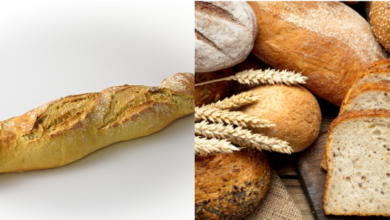How to Rehydrate Bread – Here’s How!

What To Know
- Now that we have a better understanding of the staling process, let’s delve into the practical steps involved in rehydrating a baguette.
- Try rehydrating the baguette for a shorter period or ensuring the foil is securely wrapped around the bread.
- Try rehydrating the baguette for a shorter period or using a damp cloth instead of aluminum foil.
The baguette, an iconic French bread with a crispy crust and airy interior, is a culinary masterpiece that has captured the hearts of bread enthusiasts worldwide. However, as time passes, even the freshest baguettes can lose their delightful texture and become stale. Fear not, for there are effective techniques to rehydrate and revitalize your baguettes, restoring their original glory. In this comprehensive guide, we will explore the art of baguette rehydration, providing step-by-step instructions and valuable tips to ensure a successful revival.
Understanding the Science Behind Baguette Staling
To effectively rehydrate a baguette, it is essential to understand the scientific process behind staling. Staling occurs when the starch molecules in bread undergo a process called retrogradation. During this process, the starch molecules rearrange themselves, causing the bread to become hard and dry. Retrogradation is accelerated by several factors, including exposure to air, low temperatures, and the loss of moisture.
Rehydrating Baguette: A Step-by-Step Guide
Now that we have a better understanding of the staling process, let’s delve into the practical steps involved in rehydrating a baguette:
1. Preheat Your Oven:
Preheat your oven to 350°F (175°C). This creates an ideal environment for rehydrating the baguette without overcooking it.
2. Prepare a Baking Sheet:
Line a baking sheet with parchment paper or a silicone baking mat to prevent the baguette from sticking.
3. Wrap the Baguette:
Wrap the baguette tightly in aluminum foil, ensuring that it is completely covered. This helps trap the steam and moisture during the rehydration process.
4. Bake the Wrapped Baguette:
Place the wrapped baguette on the prepared baking sheet and bake it for approximately 10-15 minutes. The exact baking time may vary depending on the size and freshness of the baguette.
5. Unwrap and Slice:
Once the baking time is complete, carefully unwrap the baguette and let it cool slightly before slicing. This will help prevent the bread from crumbling.
6. Enjoy Your Revived Baguette:
Your rehydrated baguette is now ready to be enjoyed! Savor its restored crispiness and airy texture, perfect for sandwiches, toast, or simply as a delightful accompaniment to your favorite meal.
Additional Tips for Successful Baguette Rehydration:
- Use fresh baguettes whenever possible. Stale baguettes may not respond as well to the rehydration process.
- If you don’t have aluminum foil, you can use a damp cloth to wrap the baguette before baking.
- For a crispier crust, brush the baguette with water before wrapping it in aluminum foil.
- Keep a close eye on the baguette during baking to prevent overcooking.
- Allow the rehydrated baguette to cool slightly before slicing to prevent crumbling.
Storing and Preserving Baguettes for Optimal Freshness:
To maintain the freshness of your baguettes and minimize the need for rehydration, consider the following storage tips:
- Store baguettes at room temperature in a bread box or airtight container.
- Avoid storing baguettes in the refrigerator, as this can accelerate the staling process.
- If you plan to store baguettes for more than a few days, consider freezing them. Frozen baguettes can be thawed at room temperature or reheated in the oven before serving.
Troubleshooting Common Baguette Rehydration Issues:
1. Baguette is Still Hard After Rehydration:
If your baguette is still hard after rehydration, it may have been overcooked or the aluminum foil was not wrapped tightly enough. Try rehydrating the baguette for a shorter period or ensuring the foil is securely wrapped around the bread.
2. Baguette is Too Soggy After Rehydration:
If your baguette is too soggy after rehydration, it may have been wrapped too tightly in aluminum foil or baked for too long. Try rehydrating the baguette for a shorter period or using a damp cloth instead of aluminum foil.
3. Baguette Crumbles When Sliced:
If your baguette crumbles when sliced, it may have been overcooked or allowed to cool too quickly. Try rehydrating the baguette for a shorter period or letting it cool completely before slicing.
Reheating Baguettes: Alternative Methods to Restore Freshness:
In addition to rehydrating baguettes in the oven, you can also use other methods to restore their freshness:
- Microwave: Wrap the baguette in a damp paper towel and microwave it on high for 10-15 seconds. Be careful not to overcook the baguette, as this can make it tough and chewy.
- Toaster: Slice the baguette and toast it in a toaster until it reaches your desired level of crispiness. This method is best for creating crispy croutons or bruschetta.
- Skillet: Heat a skillet over medium heat and add a small amount of butter or oil. Toast the baguette slices in the skillet until they are golden brown and crispy. This method is perfect for creating a warm and savory breakfast toast.
Reviving Baguettes: A Culinary Art Form
Rehydrating baguettes is an art form that requires patience, attention to detail, and a deep appreciation for the nuances of bread. By understanding the science behind staling and following the techniques outlined in this guide, you can successfully revive stale baguettes, transforming them into delectable treats that will delight your taste buds.
Beyond Rehydration: Exploring Creative Uses for Baguettes
Beyond rehydrating baguettes, there are countless creative ways to use them in your culinary adventures:
- Croutons: Cut baguettes into cubes and toast them in the oven or skillet to create crispy croutons for salads, soups, and casseroles.
- Bruschetta: Top baguette slices with fresh tomatoes, basil, and olive oil to create classic Italian bruschetta.
- Garlic Bread: Brush baguette slices with melted butter, garlic, and herbs, then bake until golden brown. Serve as a side dish or appetizer.
- French Toast: Slice baguettes and soak them in a mixture of eggs, milk, and spices. Cook in a skillet until golden brown and serve with your favorite toppings.
- Breadcrumbs: Crumble stale baguettes in a food processor to create fresh breadcrumbs for coating fried foods or adding texture to meatballs and casseroles.
Common Questions and Answers
1. Can I rehydrate a baguette in the microwave?
Yes, you can rehydrate a baguette in the microwave. Wrap the baguette in a damp paper towel and microwave it on high for 10-15 seconds. Be careful not to overcook the baguette, as this can make it tough and chewy.
2. Can I rehydrate a baguette in a toaster?
Yes, you can rehydrate a baguette in a toaster. Slice the baguette and toast it in a toaster until it reaches your desired level of crispiness. This method is best for creating crispy croutons or bruschetta.
3. Can I rehydrate a baguette in a skillet?
Yes, you can rehydrate a baguette in a skillet. Heat a skillet over medium heat and add a small amount of butter or oil. Toast the baguette slices in the skillet until they are golden brown and crispy. This method is perfect for creating a warm and savory breakfast toast.
4. How can I store baguettes to maintain their freshness?
Store baguettes at room temperature in a bread box or airtight container. Avoid storing baguettes in the refrigerator, as this can accelerate the staling process. If you plan to store baguettes for more than a few days, consider freezing them. Frozen baguettes can be thawed at room temperature or reheated in the oven before serving.





